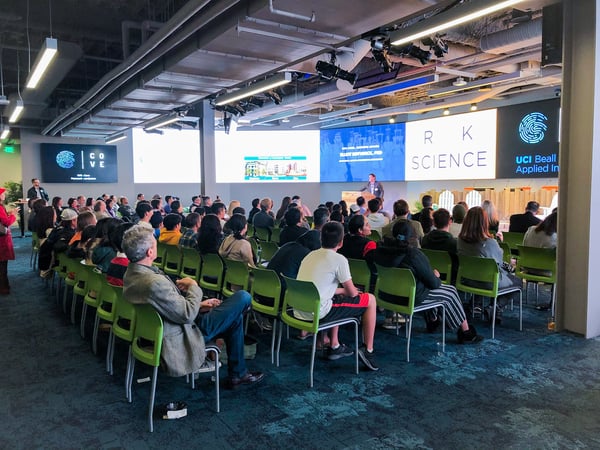Learn about the SBIR program and how scientist-entrepreneurs can avoid common pitfalls.
Funding for early stage startups is one of the biggest challenges that biotech and medtech entrepreneurs face. The Small Business Innovation Research (SBIR) program is a popular way for young companies to attempt to acquire funding, but there is increasing competition for these funds. Read on to learn about the SBIR program and how scientist-entrepreneurs can avoid common pitfalls when crafting proposals themselves.
🔬Read: What are SBIR/STTR Grants?

The SBIR program awards grants to small businesses with the goal of stimulating innovation and research that will eventually be commercialized. The SBIR program was created to stimulate technological innovation, use small businesses to meet Federal research and development needs, help socially and economically disadvantaged small businesses in technological innovation, and increase private sector commercialization of innovations derived from Federal research and development. Since it’s inception, the SBIR program has grown to act like seed capital for young companies, and therefore places an emphasis on whether or not a technology has the potential for commercialization. One big benefit for startups who win SBIR funding is that it is non-dilutive—no equity is required in exchange for the money.
Since 2017, all Federal agencies with over $100 million in extramural research and development budgets are required to allocate 3.2% of that money to the SBIR program. Thus, there are eleven federal agencies that offer SBIR grants. Each agency has its own processes, so this article will focus on those that most frequently fund biotech and medtech companies: National Institutes of Health (NIH) and National Science Foundation (NSF).
🔬 Learn about: Funding Options for Biotech Startups
To be eligible for an SBIR grant, the applicant must be a small business. Investopedia defines business as “the organized efforts and activities of individuals to produce and sell goods and services for profit.” Therefore, research conducted purely for discovery or even for the good of humanity is not a business unless someone is willing to buy it.
Therein is the essential difference between an academic grant and an SBIR—an academic grant is focused on discovery, whereas an SBIR is focused on commercialization. That means that the goal of SBIR funding is to develop a product, rather than to publish a paper. The SBIR program is not meant to fund basic research, it is meant to fund technologies that will make money.
Another difference between SBIRs and academic grants is the expectation placed upon academic inventors. The SBIR program requires that the primary investigator (PI) on the grant dedicate over 50% of his/her time and effort to the project. This means that anyone with another full-time job is not eligible to be the PI. In other words, the professor from whose lab the technology was developed can’t be the PI unless they quit their professorship.
Other differences include the structure of the application (which varies by agency as well) and the central focus on innovation and future commercialization.
Before beginning the writing process, first determine if an SBIR is the right fit for the company. A phase I SBIR award is $150k-$225k over a 6-12 month period. Therefore, it is not expected that a Phase I will cover all the work that is needed to prepare for a Phase II SBIR, which is the whole goal of a Phase I. Another deciding factor is that an SBIR proposal can take between 150 and 450 hours of work. Some startups simply don't have that kind of time and may be in a position to find other types of funding more easily.
Also, startups must keep in mind that there’s at least a 6 month gap between submission and funding. More often this is 9-12 months. Expect at least 6 months between Phase I and Phase II without gap funding.
If and SBIR is the right fit, then these questions are essential for any startup to answer prior to beginning to write:
Finally, there is a registration process before submitting an SBIR proposal that can take between six and eight weeks. The five registrations needed are: EIN, DUNS, SAM, Grants.gov, eRA, and SBA company registry.

SBIR program managers are the equivalent of program officers for academic grants. And just as with academic grants, it's a good idea to get to know them. They are not allowed to give specifics to applicants that call on exactly what to write and many will get frustrated if asked that question. According to Don Johnson, PhD, Founder and Executive Partner of Johnson Consulting:
"Ask questions such as, 'I see that the application says X—have there been any changes since the [request for proposals] RFP was published?' 'The RFP asks for these 4 areas. I interpret this to mean that #1 is the most important, do you agree?' 'What is meant by this sentence in the RFP?' “We are planning to do X, is that a good fit for this solicitation?' You are trying to get them to start talking about the solicitation and give you as much information as they are willing to. If the officer’s response is vague or repeats the wording of the RFP basically verbatim, that probably means they are not going to give you any more information and you would do best to try not to annoy them."
The program manager will be handling your application at some point, so treat them as a decision maker. Applicants who pester their program manager or ask questions they can't answer will be frowned upon. The point is to find out whether or not the project that a company is proposing is a good fit for the solicitation so the entrepreneur doesn't waste time by applying. And if the RFP is a good fit, the program manager can hopefully provide enough clues to determine which aspects to emphasize in the proposal. Dr. Johnson says, "this aspect of preparing an SBIR proposal is an art, not a science."
🔬Read more about: How Incubators Can Improve Your SBIR/STTR Grant Application

The ability to write for one's specific audience is an important skill for an entrepreneur, and one that scientists may initially find challenging. For tips on communicating in the startup world, see this post.
Dr. Johnson advises scientists, "Reviewers only spend a few seconds to minutes with each proposal. Make sure they don’t have to work to understand it. Write for a 7th-8th grade reading level. The person reading your proposal may not be a subject area expert."
However, there will likely be experts reading the proposal at some point, so while teaching a non-expert enough to understand the value of the work, the proposal must also convince an expert that the team is credible. Generally, this can be accomplished by including the relevant information without getting too far "into the weeds" or listing details that are not essential to understand. The ability to select the most important information and not get bogged down in the details will convince experts of the PI's credibility more than an exhaustive explanation of experimental minutiae.
Each SBIR-awarding agency has different review criteria that can be significantly different. The NIH for example looks for the following factors:
Phase II applications require the above plus a commercialization plan that is credible and letters of support from potential commercialization partners.
🔬Related: 10 Tips for a Competitive SBIR or STTR Proposal
Phase II proposals must also show that the company succeeded in Phase I to prepare for what they propose in Phase II.
Frequently, proposals will be rejected because the applicants failed to follow directions or requested the wrong institute or study section for review. The majority of these issues can be prevented by talking to the program manager before submitting the proposal. Other reasons for rejection include: Lack of originality, lack of rational science, poorly formed research plan, illogical experimental approach, lack of experience with the proposed methods, infeasible amount of work for the timeline, lack of objective metrics, insufficient statistical analysis, and unconvincing commercial or societal impact.
All of these issues are addressed by following the SBIR submission guidelines, doing plenty of background research, and having a team with sufficient experience in the applicable scientific areas. However, it is also possible to have a concept that just won’t cut it. If the technology isn’t innovative nor being used to address a significant problem, if it isn’t a feasible product to develop, or if it’s not better than what competitors are offering, those are not issues that following the directions can solve.
SBIR proposals are time-consuming and challenging. If it's too much to take on, there are plenty of consultants and services that startups can hire to help with the process. However, writing a successful SBIR is a great skill for a scientist-entrepreneur to learn.
Luckily there are numerous resources for those who are writing SBIR proposals for the first time. The SBIR website has a series of tutorials available to watch. Click here to see a pre-recorded webinar on writing SBIR proposals.
Download The Ultimate Guide to Wet Lab Incubators in Southern California, a handbook to assist life science start-ups through the entire decision-making process to find wet lab space.
Download Now